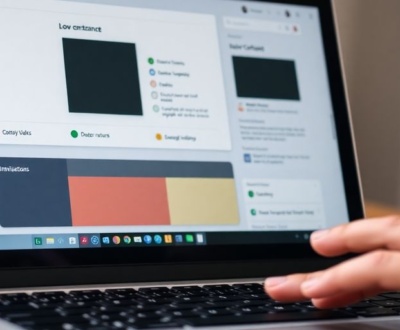Interactive Design in 2024: Merging Parallax, 3D, and Micro-Interactions for Engagement
- October 26, 2024
- Blog
As we step into 2024, the world of interactive design is evolving rapidly. Designers are blending techniques like parallax scrolling, 3D elements, and micro-interactions to create engaging experiences that capture users’ attention. This article explores these trends and how they can enhance user engagement in the digital space.
Key Takeaways
- Interactive design is changing quickly, focusing on blending different techniques for better user experiences.
- Parallax scrolling adds depth and movement, making websites more engaging as users scroll.
- 3D elements are becoming more common, allowing users to interact with lifelike visuals and enhancing realism.
- Micro-interactions, including haptic feedback, provide users with instant responses, making their experience feel more dynamic.
- The future of design will include AI, AR, and a focus on accessibility, ensuring that everyone can enjoy digital experiences.
The Evolution of Interactive Design in 2024
Historical Context and Trends
Interactive design has come a long way, evolving with technology and user expectations. In 2024, we see a blend of creativity and technology that shapes how users interact with websites. The rise of dynamic, accessible, and engaging web experiences is evident, influenced by trends like Y2K nostalgia and sci-fi aesthetics.
Key Drivers of Change
Several factors are driving the evolution of interactive design:
- Technological advancements: New tools and software make it easier to create engaging designs.
- User expectations: Users now demand more interactive and personalized experiences.
- Cultural influences: Trends from pop culture often inspire design choices.
Future Predictions
Looking ahead, we can expect:
- Increased use of AI: AI will play a bigger role in personalizing user experiences.
- More immersive designs: Expect to see more 3D elements and parallax scrolling.
- Focus on sustainability: Designers will prioritize eco-friendly practices in their work.
The future of interactive design is bright, with endless possibilities for creativity and engagement.
| Trend | Description |
|---|---|
| Microinteractions | Small animations that enhance user experience. |
| 3D Elements | Interactive models that users can manipulate. |
| Gamification | Adding game-like elements to boost engagement. |
Integrating Parallax Scrolling for Enhanced User Engagement
Understanding Parallax Scrolling
Parallax scrolling is a design technique that creates a 3D effect by moving background images at a different speed than the foreground. This effect can make a website feel more dynamic and engaging. It’s like watching a movie where the background and characters move at different speeds, creating depth and interest.
Best Practices for Implementation
To effectively use parallax scrolling, consider the following:
- Keep it subtle: Too much movement can distract users.
- Optimize for speed: Ensure that the scrolling is smooth and doesn’t lag.
- Test on multiple devices: Make sure it works well on both desktops and mobile devices.
Case Studies of Successful Use
Many websites have successfully integrated parallax scrolling. Here are a few examples:
- Webflow: Their design showcases stunning graphics with smooth parallax effects.
- Nike: Uses parallax to tell a story about their products, enhancing user engagement.
- Spotify: Engages users with a dynamic scrolling experience that highlights their music offerings.
Parallax scrolling can significantly enhance user engagement by creating a captivating experience that keeps visitors interested and encourages them to explore more content.
By understanding and implementing parallax scrolling effectively, designers can create websites that not only look great but also keep users engaged and coming back for more.
Remember, the goal is to enhance user engagement with parallax scrolling effects.
The Rise of 3D Elements in Web Design

Technological Advancements Enabling 3D
3D elements are becoming a key part of web design, thanks to new technologies. These advancements allow designers to create more engaging experiences. Some of the main technologies include:
- WebGL: Enables real-time 3D graphics in browsers.
- CSS3: Helps in creating 3D effects with simple code.
- JavaScript Libraries: Libraries like Three.js make it easier to add 3D elements.
Applications of 3D in Various Industries
3D design is not just for fun; it has real applications across different fields. Here are some examples:
- E-commerce: Users can view products in 3D, helping them make better choices.
- Education: 3D models can make learning more interactive and fun.
- Gaming: 3D elements create immersive experiences that keep players engaged.
Challenges and Solutions
While 3D design is exciting, it comes with challenges. Here are some common issues and how to solve them:
| Challenge | Solution |
|---|---|
| Performance Issues | Optimize 3D models for faster load times. |
| User Experience | Ensure 3D elements are easy to use and navigate. |
| Compatibility | Test designs on different devices and browsers. |
3D elements can make websites more engaging, but they must be used wisely to avoid overwhelming users. Balancing creativity with usability is key.
Micro-Interactions: Small Details, Big Impact

Micro-interactions are the tiny design details that make a big difference in how users experience a website. They respond to user actions or system changes with small visual, sound, or touch cues, making the experience feel more natural. These small animations can significantly enhance user satisfaction.
Defining Micro-Interactions
Micro-interactions are brief moments that occur when a user interacts with a digital platform. They can include:
- Button animations when clicked
- Notifications that pop up when an action is completed
- Visual feedback when a user hovers over an element
These interactions help guide users and provide immediate feedback, making the experience smoother and more enjoyable.
Examples of Effective Micro-Interactions
Here are some popular examples of micro-interactions:
- Like Button Animation: When you click the "Like" button on social media, it often changes color or shows a small animation.
- Loading Indicators: A spinning wheel or progress bar that shows the status of an action.
- Form Validation: A checkmark that appears when a user fills out a form correctly.
These examples show how micro-interactions can enhance usability and engagement.
The Role of Haptic Feedback
Haptic feedback adds a tactile element to micro-interactions. For instance, when you tap a button on a mobile device, you might feel a slight vibration. This feedback makes the interaction feel more real and satisfying.
Micro-interactions are essential for guiding users and enhancing their experience. They may be small, but their impact is significant.
In conclusion, incorporating high-quality micro-interactions into your website can lead to happier users and a more engaging experience. As we look to the future, expect to see even more innovative uses of micro-interactions that adapt to user behavior and preferences, making the digital world feel more personalized and intuitive.
| Micro-Interaction Type | Purpose | Example |
|---|---|---|
| Button Animation | Feedback | Like button |
| Loading Indicator | Status | Spinning wheel |
| Form Validation | Confirmation | Checkmark |
Combining Parallax, 3D, and Micro-Interactions for a Cohesive Experience
Design Principles for Integration
To create a seamless experience, designers should consider the following principles:
- Balance: Ensure that no single element overwhelms the others.
- Consistency: Use similar styles and animations across all elements.
- User-Centric: Focus on how users interact with the design.
Tools and Technologies
Here are some popular tools that can help integrate these elements:
- WebGL: For rendering 3D graphics.
- GSAP: For smooth animations and transitions.
- Three.js: A JavaScript library for creating 3D graphics.
Measuring User Engagement
To assess the effectiveness of your design, consider these metrics:
| Metric | Description |
|---|---|
| Bounce Rate | Percentage of visitors leaving the site |
| Time on Page | Average time users spend on a page |
| Click-Through Rate | Percentage of users clicking on elements |
Combining parallax, 3D, and micro-interactions can create a captivating user experience. This approach not only enhances visual appeal but also encourages user engagement, making your website more memorable.
By thoughtfully merging these elements, designers can craft a cohesive and engaging digital environment that captivates users and keeps them coming back for more.
Future Trends in Interactive Design
AI and Machine Learning
The future of interactive design is heavily influenced by AI and machine learning. These technologies will help create more personalized user experiences. Designers can expect AI to analyze user behavior and suggest improvements, making websites smarter and more engaging.
Augmented Reality (AR) Integration
Augmented reality (AR) is set to change how users interact with websites. By blending digital elements with the real world, AR can create immersive experiences. For example, users might try on clothes virtually or see how furniture looks in their home before buying.
Sustainability and Accessibility
Sustainability is becoming a key focus in design. Designers are now prioritizing eco-friendly practices, such as using lightweight graphics and minimalist designs. Additionally, accessibility is crucial, ensuring that all users, including those with disabilities, can enjoy a seamless experience.
The design world is evolving, and staying ahead of trends is essential for success.
| Trend | Description |
|---|---|
| AI and Machine Learning | Personalized user experiences through data analysis. |
| Augmented Reality (AR) | Blending digital and real-world elements for engagement. |
| Sustainability | Eco-friendly practices in design. |
| Accessibility | Ensuring usability for all users. |
Conclusion
In 2024, interactive design is all about making websites more fun and engaging. By combining parallax effects, 3D elements, and small animations called micro-interactions, designers can create experiences that feel real and exciting. These features not only grab attention but also help users feel more connected to the content. As we move forward, it’s clear that the goal is to make digital spaces more enjoyable and easier to use for everyone. With these new trends, the future of web design looks bright and full of possibilities.
Frequently Asked Questions
What is interactive design?
Interactive design is about creating websites and apps that users can easily engage with. It focuses on making the experience enjoyable through features like animations and responsive elements.
How does parallax scrolling work?
Parallax scrolling is a technique where the background moves slower than the foreground as you scroll. This creates a 3D effect that makes the website feel more dynamic and engaging.
Why are micro-interactions important?
Micro-interactions are small animations or effects that give feedback to users. They help make the experience smoother and more enjoyable, like showing a thumbs-up when you like something.
What role do 3D elements play in web design?
3D elements add depth and realism to websites. They can make the design more attractive and interactive, allowing users to engage with products in a more lifelike way.
How can I measure user engagement on my site?
You can measure user engagement by looking at metrics like how long users stay on your site, how many pages they visit, and how often they interact with features like buttons or forms.
What are the future trends in interactive design?
Future trends include the use of AI for personalized experiences, more integration of augmented reality, and a focus on making designs accessible for everyone.
About this blog
We are a digital marketing company with a focus on helping our customers achieve great results across several key areas.
Request a free quote
We offer professional SEO services that help websites increase their organic search score drastically in order to compete for the highest rankings even when it comes to highly competitive keywords.









